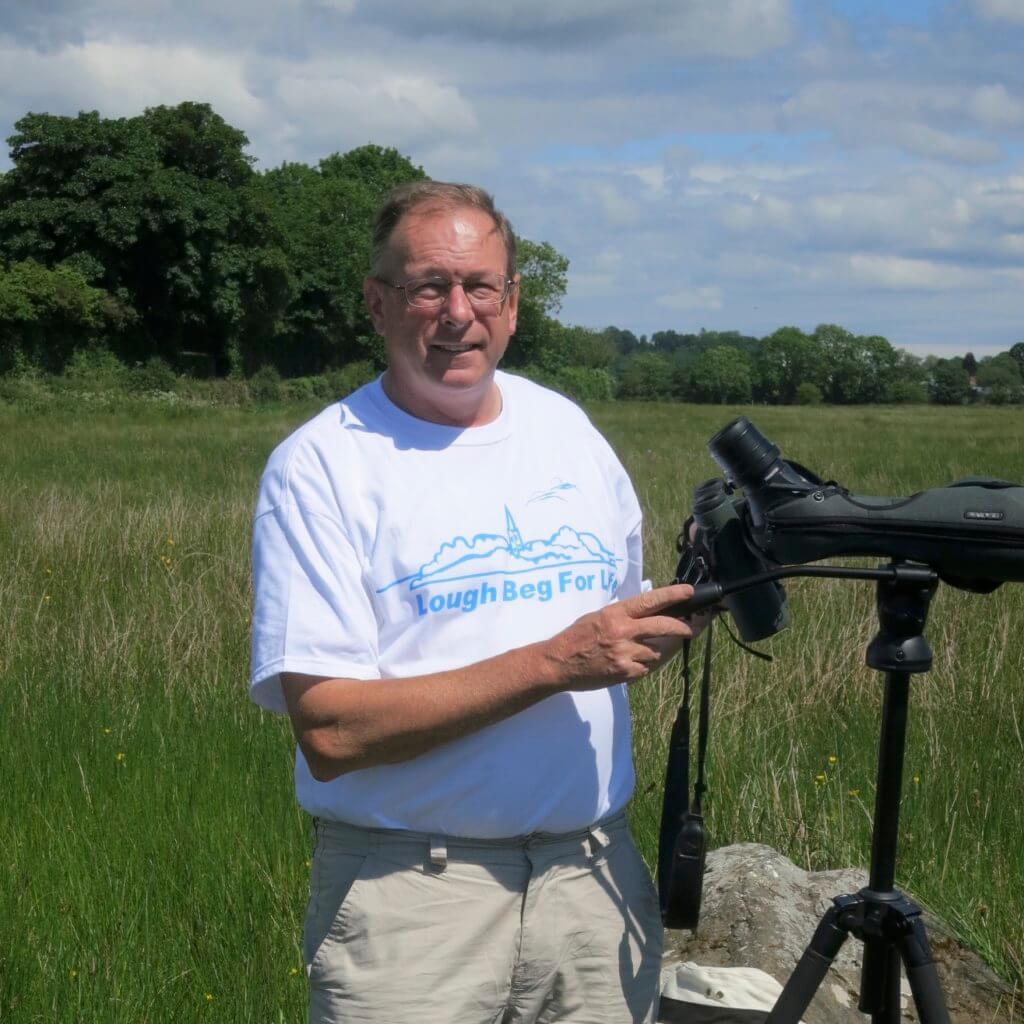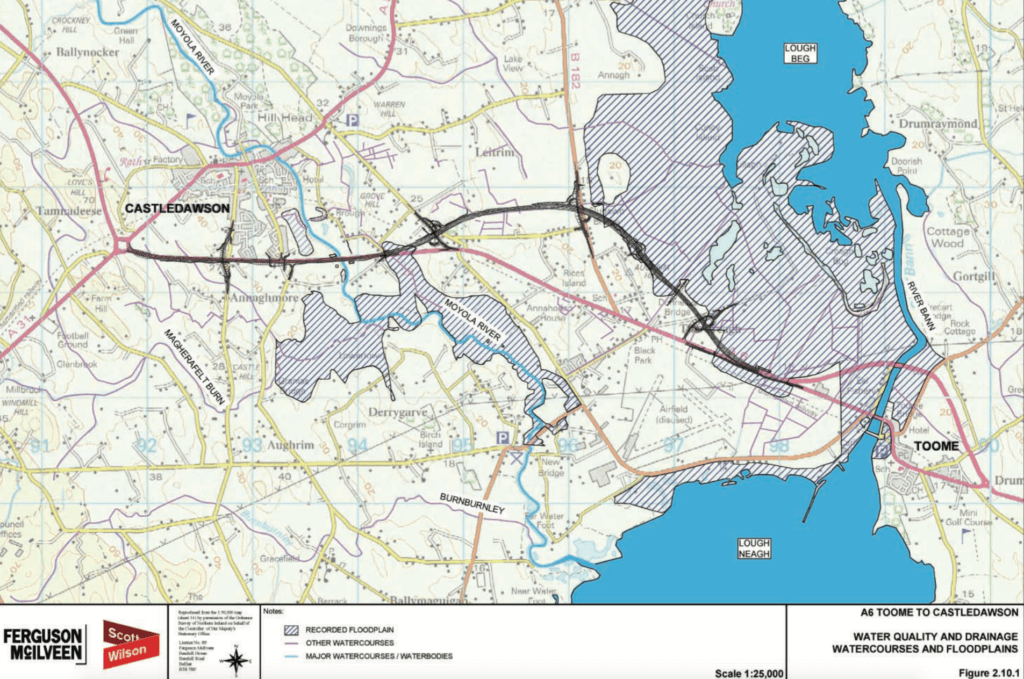
Chris Murphy has lived in Northern Ireland since arriving on the ferry from Liverpool in 1984 as the RSPB’s first, and last, Assistant Regional Officer. Together with his German wife, Doris, he’s known to shout HALT! when special places are threatened like the Belfast Harbour Pools and the Bog Meadows – once zoned for development, now nature reserves. He presently chairs two awareness-raising groups: Lecale Conservation where he lives in County Down and Lough Beg for Life.
Threatened: UK’s largest lake and its beautiful little sister
The watchword of Dr Luc Hoffmann was ‘the Bigger the Better’. It was Hoffman’s visionary conference for wetland ecologists in 1962 that evolved into the Ramsar Convention of 1971, the world’s first intergovernmental conservation treaty. The dangers of fragmentation, ‘death by a thousand cuts’, now hangs over the UK’s and Ireland’s largest freshwater wetland, Lough Neagh and Lough Beg. Floodwater flows from Lough Neagh through the Lower Bann into Lough Beg before spilling out over the Creagh meadows. The Creagh’s wet grassland merges, unbroken, with c.500ha of breeding wader habitat dominated by purple moor grass, rushes and temporary pools known as ‘dubs’. This historic landscape, stretching back to Mesolithic times, is one of the largest wet grasslands in the UK and the largest in Ireland east of the Erne-Shannon. It is a landscape immortalised by the Nobel Laureate, Seamus Heaney, much of whose poetry has been written “about it and out of it”. The entire floodplain of the Creagh should have been afforded full protection within the original 1976 boundaries of the Lough Neagh and Lough Beg Ramsar site, and re-asserted in 1996 when designated a Special Protection Area (SPA) and Area of Special Scientific Interest (ASSI). The fact that it isn’t protected within the SPA makes defending it more difficult.

How is the site threatened?
The NI Department for Infrastructure has begun construction of a 4-lane highway across the floodplain of the Creagh (pronounced ‘crake’), an integral part of the great wetland. That the most environmentally damaging of the three routes that were shortlisted for consideration was chosen serves to expose Northern Ireland’s eternally weak environmental governance and the frequently ineffective response to it from UK and Northern Ireland nature conservation NGOs.
How important are Loughs Neagh and Beg?
The Lough Neagh basin drains 43 per cent of Northern Ireland yet surprisingly few nature conservationists fully appreciate its enormous importance to wildlife. Both its important breeding wader community and once vast flocks diving duck have been in steep decline for years. Breeding Lapwing and Curlew have declined by 90 per cent since 1987 while I can recall a time when there were more Pochard, Goldeneye and Scaup wintering on Loughs Neagh and Beg than on all the other lakes of Great Britain and Ireland put together. Nevertheless, it remains the number one site in the UK for 10 species of waterbird and is among the top ten UK wetlands overall. Additionally, Lough Beg is the single most important breeding site for Whooper Swans in the British Isles with five pairs in 2016, all of them successful. In spring and autumn Lough Beg acts as the principal flyway for a multitude of bird species into and out of Lough Neagh; Lough Beg itself boasts a list of 217 species, more than any comparable site in Ireland. At all times of the year it is an exceptional place for birders with the Creagh in winter home to c.500 Whooper Swans, representing c.50 per cent of the Lough Neagh basin, and c.7 per cent of Icelandic flyway populations, respectively.
Seamus Heaney was many things but an ecologist he would probably never have claimed to be yet he understood that a highway through the Creagh would be an “ecological wound to a precious wetland”. It should be obvious to any objectively-minded ecologist looking out to Church Island from Aughrim Hill or crouching beside McGrogan’s Hole as the Whoopers come in to roost that the Government’s ‘Red Variant’ route will do irreparable harm to the ‘naturalness’ of this rare, wetland landscape, and by fragmenting the Creagh will have a profound and permanent adverse effect on the biodiversity potential of Lough Beg and the integrity of the Lough Neagh and Lough Beg SPA. Such a road would also introduce the possibility of future potential threats ranging from pullution to ribbon development.
My legal challenge
Protecting the Creagh (from this A6 dualling scheme and any other major developments) must be regarded as fundamental to meeting the conservation objectives of EU and other designations. Despite numerous appeals to leading conservation NGOs none is opposing the road. However, with the support of a great many generous and learned individuals ‘the remedy of last resort’ – judicial review – is now underway. The action is being brought by myself, as a litigant in person. Specifically I am challenging the lawfulness of the decision by the Minister for Infrastructure, Mr Chris Hazzard, to build this road through the Creagh. The basis of my argument is that his decision goes against established principles of conservation science including adopting the ‘precautionary principle’ in accordance with the procedures of the Habitats Directive. On my fourth day in court leave was granted.

What now?
The substantive hearing is scheduled for early February 2017, sooner if the Department for Infrastructure has prepared its case before the end of the year. I will have three weeks to prepare my response. In the meantime the campaign to raise awareness goes on and I should be grateful if you would help spread the word that the Lough Neagh and Lough Beg SPA is a wetland of great wildlife importance and while currently undervalued and neglected, is not being forgotten! If any readers happen to be wetland ecologists/conservationists and are interested in coming to Northern Ireland to see Lough Beg and the Creagh for themselves please get in touch and I will do all I can to assist.
Dermott Hickson, a young father from Lough Beg and past winner of the Seamus Heaney Prize for Poetry recently made a short film which shows earth works continuing apace despite agreements not to work between late-September and mid-March in this sensitive area. Even if such mitigation were to be implemented – and going by past experience that’s a big ‘if’ – no amount of monitoring, academic studies or tweaking of field boundaries will compensate for the damage of building a highway across the Creagh and so close to Lough Beg.
In 2005 Seamus Heaney wrote to Peter Hain, then Secretary of State for Northern Ireland, asking the government “…not to damage the ecology of Lough Beg. You could widen the existing road or go through the industrial estate to the south but please spare the Creagh meadows.”
You can help by signing the petition, leaving a comment and lobbying the UK.

Is this not the capital of Swifts in Britain with birds moving from Scotland and North of England to feed on the abundance of midges?
john – that is an interesting idea
That’s right, John. They seem to have the longest UK swift season, with very early birds and late leavers, even after breeding has finished. There is one guy who has a swift colony of around 25-30 pairs, plus house martins and swallows! Must be wonderful in summer.
https://m.youtube.com/watch?v=UOLo7N81uOA
It’s certainly the capital of swifts for Northern Ireland at least. Can’t give too much away but recent work has shown Lough Neagh to be the central feeding ground for swifts from all over NI – and it’s part of the reason why Northern Ireland has such a great breeding population of swifts still. As far as I can tell, that birds move from GB to NI to feed is based on speculation, but it would be interesting to find out for sure.
At the BTO conference last weekend one talk focused on the dramatic fall in curlew numbers in Ireland. It’s just perverse that this red-listed bird’s plight is also ignored by these plans.
http://www.independent.co.uk/voices/nature-studies-if-we-lose-the-curlew-we-lose-the-sound-of-the-british-wilderness-a6889956.html
Chris, many thanks for all your hard campaigning and the best of Irish re the JR. All power to your legal beavering leading up to your days in court.
Signed plus comment.
Good luck and well done for pursuing this cause.